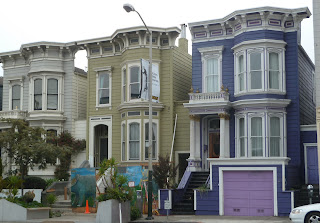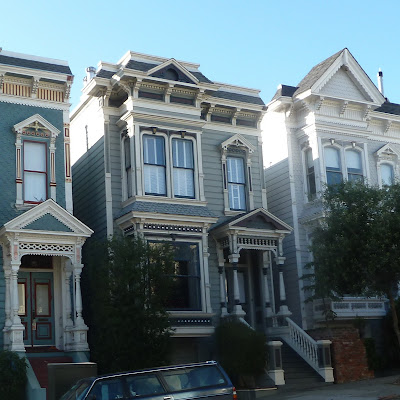[My SF Past] Quick Guide to Victorian Architecture
72 views
Skip to first unread message
Gloria Lenhart
Mar 4, 2012, 8:46:56 PM3/4/12
to san-francisco-adv...@googlegroups.com
Most San Francisco Victorians were built in one of three major styles. The style is a good indication of roughly when the home was built. Here's a quick guide:
Early 1870s – Flat-front VictoriansFlat fronts are some of the earliest built houses in the city. This style was more likely to be built as a single or in twos, rather than in rows. Decoration is minimal and was often done by hand.
Look for:
False front extending above a flat or pitched roof
Cornice held up by multiple brackets
1890s Queen Anne
Of the remaining Victorians, the Queen Anne row house is the predominant style with some 5,500 standing. There are around 3,600 Stick style homes left, about1,200 Italianate bays and 1,900 flat fronts. The Queen Anne Tower, the largest and most expensive to build, are also the most rare, with less than 400 left.
The study of San Francisco Victorian buildings is complicated by the loss of building records in the 1906 Fire, the confusion resulting from the renumbering of many streets afterward, as well as the extensive modifications made to some structures over the years. In fact, the Ms. Lynch concludes that more than half of the existing Victorians have been “improved” most often by the addition of stucco.
Outside of San Francisco, clusters of Victorians can still be found in Oakland, Alamdea, Berkeley, San Jose and parts of Marin County.
--
Posted By Gloria Lenhart to My SF Past at 10/04/2011 03:26:00 PM
Early 1870s – Flat-front VictoriansFlat fronts are some of the earliest built houses in the city. This style was more likely to be built as a single or in twos, rather than in rows. Decoration is minimal and was often done by hand.
Look for:
False front extending above a flat or pitched roof
Cornice held up by multiple brackets
Plain, lapped siding
Simple window hoods
Simple window hoods
Later 1870s - Italianate Slanted Bay
The Italiante style pumps up the flat front with slanted bay windows and adds classic details like columns and oversize cornices. The idea was to look like a small Italian villa. Some were originally painted dark colors to mimic stone. Best examples seen in Lower Pacific Heights and the Mission, both early-built neighborhoods. .
Look for:
Slanted bay windows
Tiny Juliet balcony over the front porch
Classic columns around front door
Large cornices extending above roof line
1880s Stick - Square Bay
By the 1880s, steam-powered tools made geometric, machine-cut trim available and affordable. Homeowners selected decorative trims out of catalogs and builders often bought popular pieces in bulk.
Look for:
Squared off bay windows
Straight lines
Gabled roof
Repetitive use of small decorative trim
Rows of machine made geometric elements decorate this
restored stick in the Castro.
|
1890s Queen Anne
The Queen Anne is most elaborate and eccentric style of the Victorians era. There are two types: Tower and Row. The Tower version was the most expensive to build and is the most rare: In 1970 there were less than 400 towers remaining. The Queen Anne Row house is much more common. Haight-Ashbury and the Castro have the largest concentrations of this style because they were built out later.
There’s no clear explanation of where the name comes from, but it seems to have little to do with the British monarch who died in 1714.
There’s no clear explanation of where the name comes from, but it seems to have little to do with the British monarch who died in 1714.
| Restored Queen Anne Tower on Page at Ashbury. |
Look for:
Gabled roof
Decorative shingles
Rounded or arched windows
Tower or turret
Decorative finials or weathervanes
Stained or leaded glass
Elaborate 3-D plaster or pressed wood decorations
How many Victorians remain?
In 1973, Judith Lynch, founder of City Guides, found 13,487 Victorian era structures still standing, based on a survey on nine San Francisco neighborhoods, funded by a grant from the National Endowment for the Arts.Of the remaining Victorians, the Queen Anne row house is the predominant style with some 5,500 standing. There are around 3,600 Stick style homes left, about1,200 Italianate bays and 1,900 flat fronts. The Queen Anne Tower, the largest and most expensive to build, are also the most rare, with less than 400 left.
The study of San Francisco Victorian buildings is complicated by the loss of building records in the 1906 Fire, the confusion resulting from the renumbering of many streets afterward, as well as the extensive modifications made to some structures over the years. In fact, the Ms. Lynch concludes that more than half of the existing Victorians have been “improved” most often by the addition of stucco.
| Two different Victorian remodels, on Page St. in the Haight. . |
Learn more: Victoria’s Legacy – Tours of San Francsico Bay Area Architecture, Judith Lynch Waldhorn and Sally B. Woodridge, 1978.
--
Posted By Gloria Lenhart to My SF Past at 10/04/2011 03:26:00 PM
Reply all
Reply to author
Forward
0 new messages



